Short answer: Sourdough bread should typically rest for about 30 minutes to 2 hours after coming out of the oven. This allows it to cool and the crumb to set, resulting in cleaner slices.
Understanding the right time to slice your freshly baked sourdough bread is crucial in order to maintain its structure and taste. While it might be tempting to cut into a warm, crusty loaf of sourdough right out of the oven, it’s best to wait. Typically, you should let the sourdough bread rest for about 30 minutes to two hours. This allows the bread to cool and the crumb – the interior of the bread – to set properly. Cutting into the bread too soon can cause the crumb to compress and become gummy, impacting the texture and potentially the flavor of your sourdough.
What Is Sourdough?
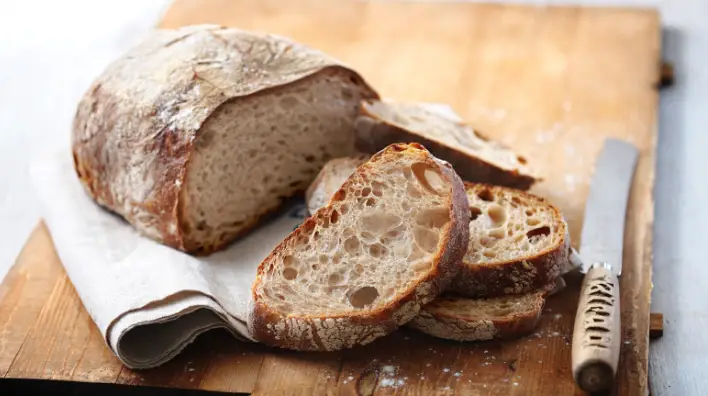
Sourdough is a type of bread made from a naturally fermented mixture of flour and water, often called a ‘starter’. This starter contains wild yeasts and lactobacilli, which make the bread rise and give it its distinctive tangy flavor. The process of making sourdough can be more time-consuming than other breads because it relies on the slow action of these wild yeasts, rather than commercial baker’s yeast. The result is a loaf with a chewy texture, a slightly sour taste, and a hard, crusty exterior. Sourdough bread is also considered easier to digest and more nutritious than many other breads due to the fermentation process.
How Soon Can I Slice Sourdough?
Sourdough bread, distinct in its characteristics, requires a longer cooling period before slicing when compared to other types of homemade bread. Typically, a standard homemade bread loaf, weighing approximately 1.5 pounds, needs around two hours to cool down adequately. However, a sourdough loaf of the same weight takes a significantly longer time to reach the right temperature for slicing – at least four hours. This extended cooling time is essential in preserving the unique texture and flavor of sourdough bread.
What Happens If I Cut Sourdough Bread Before It Has Completely Cooled?
If you slice into sourdough bread before it’s fully cooled, it can negatively impact the texture and flavor. The internal structure, or the crumb, is still set during the cooling process. Cutting too soon can result in a compressed, gummy crumb. The steam trapped inside the bread, which contributes to its moistness, may escape too rapidly, potentially leading to a drier loaf.
What Happens If I Cut The Sourdough Bread, Too Long, After It Has Cooled?
If you wait too long after the bread has cooled to slice it, the loaf can become dry and stale, particularly if it’s not properly stored. This is because, over time, the moisture in the bread gradually migrates from the crumb to the crust and then evaporates into the surrounding air. However, sourdough has a longer shelf-life than most breads due to its acidity, so you do have a wider time window before it begins to stale. Nonetheless, for the best texture and flavor, it’s generally best to consume sourdough within a few days of baking.
What Happens During The Cooling Process Of Sourdough Bread?
During the cooling process of sourdough bread, several important changes happen.
- The residual heat continues to cook the inside of the bread. This ‘carry-over cooking’ solidifies the structure of the bread and ensures the crumb, the internal part of the bread, is properly set.
- The cooling process allows the steam that has formed inside the bread during baking to slowly escape. This moisture release is gradual and controlled, preventing the bread from becoming dry. If you cut into the bread too early, this steam escapes too quickly, potentially resulting in a drier loaf.
- The flavors of the bread continue to develop during cooling. The complex interactions between the yeasts and bacteria in sourdough create a variety of flavor compounds. As the bread cools, these flavors meld and mature, creating the distinctive, tangy taste that sourdough bread is known for.
How To Slice Sourdough Bread?
Slicing sourdough bread properly can ensure you get the best possible texture and flavor. Here’s a simple step-by-step guide:
Step 1: Wait for it to cool: As previously mentioned, allow the bread to cool for at least 4 hours, or until it has reached room temperature. This helps the bread to set and makes it easier to cut.
Step 2: Use a serrated knife: Sourdough bread typically has a hard, crusty exterior and a softer interior. A serrated knife is best for this, as the teeth can grip and cut through the crust without squishing the softer inside.
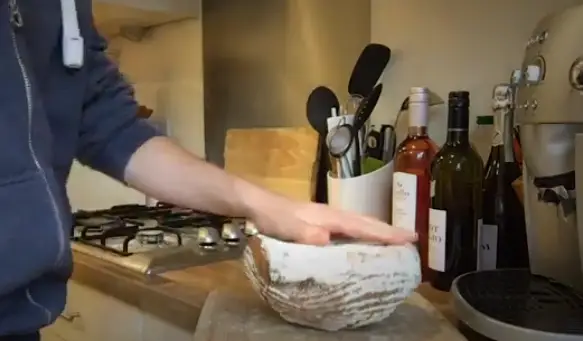
Step 3: Position the bread: If the loaf is round, you might find it easier to slice if you turn it onto its side. For longer, narrower loaves, you can keep it right side up.
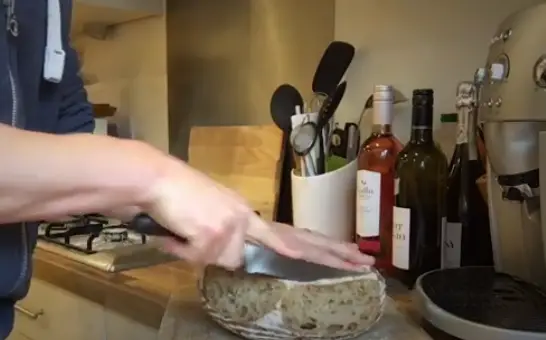
Step 4: Cut at a slight angle: This isn’t necessary, but it can result in slices with a more attractive shape and a good ratio of crust to interior.
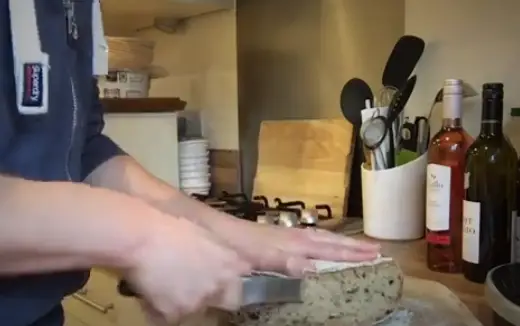
Step 5: Use a sawing motion: Don’t press down hard with the knife; instead, use a gentle back-and-forth sawing motion. Let the sharpness of the knife and this motion do the work.
Step 6: Store properly: Once you’ve sliced the bread, store the remainder properly to keep it fresh. If you’re using it within a few days, it can be stored cut-side down on a cutting board. For longer storage, consider freezing it.
Can I Speed Up The Cooling Process Of Sourdough?
While it may be tempting to try to speed up the cooling process of sourdough bread, it’s generally not recommended. The cooling period is important for the bread’s texture and flavor to fully develop. Rapid cooling may lead to a loaf that’s gummy or overly moist, as it doesn’t allow enough time for the remaining moisture to evenly distribute or for the crumb structure to be fully set.
However, if you’re really in a hurry, there are a few things you could do:
- Slice it: Cutting the bread into large chunks will increase its surface area and help it cool more quickly. However, be aware that this will also cause it to dry out more quickly.
- Use a cooling rack: If you’re not already doing so, make sure to cool your bread on a wire rack rather than a solid surface. This allows air to circulate around the entire loaf, which can speed up cooling slightly.
- Increase airflow: Using a fan to blow air over the loaf can also speed up cooling. Just be sure not to blow any dust or other contaminants onto the bread.
Remember, these methods might speed up the cooling process, but they may also affect the quality of your sourdough bread. The best way to achieve optimal flavor and texture is still to allow the bread to cool naturally.
FAQs
Why is sourdough bread too hard?
If your sourdough bread is too hard, it could be due to a number of factors. Overbaking is a common cause – if left in the oven for too long, the bread can become overly dry and the crust too hard. Another reason could be insufficient hydration in your dough; sourdough typically requires a higher hydration level compared to other types of bread. Lastly, storing bread improperly can also lead to hardening.
What is the best way to keep sourdough bread fresh?
The best way to keep sourdough bread fresh is to store it at room temperature, ideally in a bread box or paper bag, which allows the bread to ‘breathe’ while preventing it from drying out. Avoid storing bread in the refrigerator as this can cause it to stale faster. If you need to keep the bread for a more extended period, you might consider freezing it.
When should you cut the freshly baked bread?
For most homemade bread, you should wait until it has cooled completely before cutting into it. This is particularly true for sourdough bread, which typically requires at least 4 hours to cool. Cutting too soon can result in a gummy texture.
Does bread stay fresh longer if uncut?
Yes, bread generally stays fresh longer if left uncut. This is because the interior of the bread, once exposed to air, starts to dry out and stale more quickly. Therefore, it’s best only to slice bread as you need it.
How do bakers slice freshly sliced bread?
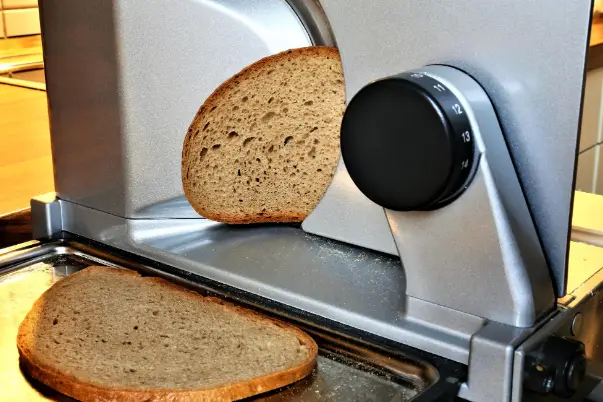
Bakers often use specially designed bread-slicing machines to uniformly and efficiently cut loaves of bread. However, when slicing by hand, they typically use a long, sharp, serrated knife and a gentle sawing motion to avoid squishing the bread.
How do you know when to stop kneading sourdough?
You can tell when to stop kneading sourdough by performing the ‘windowpane’ test. Take a small piece of dough and stretch it out. If it can stretch thin enough to be translucent without tearing, your dough has been kneaded enough. Another sign is when the dough is smooth and elastic, and it springs back slowly when poked.
Conclusion
Knowing when to slice your sourdough bread is a crucial part of the baking process. While it might be tempting to cut into the fresh, warm loaf immediately after baking, patience is key. It’s typically recommended to wait at least 2 hours for a sourdough loaf to cool before slicing. This cooling period allows the internal structure to set, the steam to escape slowly, and the flavors to fully develop. Cutting into the bread too soon can lead to a gummy texture and compromise its distinct taste. Therefore, allowing the bread to cool naturally not only ensures clean slices but also optimal flavor and texture.

Mario Batali is a renowned author, food enthusiast, and passionate chef who has dedicated his life to exploring the world of culinary arts. With a love for sharing his knowledge and experiences, Mario has become a prominent figure in the food blogging community, inspiring countless readers with his creativity and expertise.
In addition to his culinary prowess, Mario Batali is also a talented writer with a flair for engaging storytelling. He launched his own food blog to share his recipes, cooking tips, and personal experiences in the kitchen. Over time, Mario’s blog gained a loyal following of food enthusiasts who appreciate his unique approach to cooking and his dedication to using only the finest ingredients.
Mario Batali’s passion for food and his commitment to sharing his knowledge with others have made him a true inspiration in the world of culinary arts. Through his blog, cookbooks, and public appearances, Mario continues to spread his love of food and the joy of cooking with his ever-growing fanbase.






